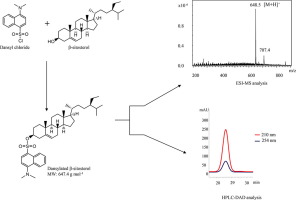Food Research International ( IF 7.0 ) Pub Date : 2020-01-13 , DOI: 10.1016/j.foodres.2020.108998 Franks Kamgang Nzekoue , Giovanni Caprioli , Massimo Ricciutelli , Manuela Cortese , Alessandro Alesi , Sauro Vittori , Gianni Sagratini

|
HPLC analyses of phytosterols are associated with the issues of sensitivity due to their high lipophilicity and their lack of chromophore. These problems could be solved through chemical modifications of plant sterols/stanols structures. Therefore, the present study aims to develop a new method for phytosterols derivatization. This method was performed using dansyl chloride (4 mg ml-1) as derivatizing agent and different reaction parameters have been optimized. The highest yields of phytosterol derivatization were obtained with 4‐dimethylaminopyridine (DMAP) as catalyst at a concentration of 8 mg ml-1 and dichloromethane as reaction solvent. In addition, 40 ˚C was the best reaction temperature for 30 min as the best reaction time. This derivatization method presented a high reproducibility (%RSD = 1.2 – 2.7%) and a good linearity (R2=0.9982 – 0.9999). The UV absorption intensities after derivatization showed a 23-fold increment for plant sterols and a 400-fold increment for plant stanols. Moreover, this derivatization method allowed the use of high and more selective wavelengths of detection and improved the chromatographic separation of phytosterols. Furthermore, the developed method allowed the ESI-MS ionization and analysis of phytosterols. This method can therefore contribute to the improvement of the HPLC analyses of plant sterols/stanols.
中文翻译:

开发一种创新的植物甾醇衍生化方法,以改进植物甾醇/甾烷醇的HPLC-DAD分析和ESI-MS检测
由于植物甾醇的亲脂性高且缺乏生色团,因此对植物甾醇进行HPLC分析与灵敏度问题有关。这些问题可以通过植物固醇/甾烷醇结构的化学修饰来解决。因此,本研究旨在开发一种植物甾醇衍生化的新方法。该方法使用丹磺酰氯(4 mg ml -1)作为衍生剂进行,并且优化了不同的反应参数。以4-二甲基氨基吡啶(DMAP)为催化剂,以8 mg ml -1的浓度可获得最高的植物甾醇衍生化作用和二氯甲烷作为反应溶剂。此外,40℃是30分钟的最佳反应温度,是最佳的反应时间。这种衍生化方法具有很高的重现性(%RSD = 1.2 – 2.7%)和良好的线性(R 2 = 0.9982 – 0.9999)。衍生化后的紫外线吸收强度显示植物甾醇增加23倍,植物甾烷醇增加400倍。此外,这种衍生化方法允许使用更高且更具选择性的检测波长,并改善了植物甾醇的色谱分离。此外,开发的方法允许ESI-MS电离和分析植物甾醇。因此,该方法可有助于改善植物固醇/甾烷醇的HPLC分析。











































 京公网安备 11010802027423号
京公网安备 11010802027423号